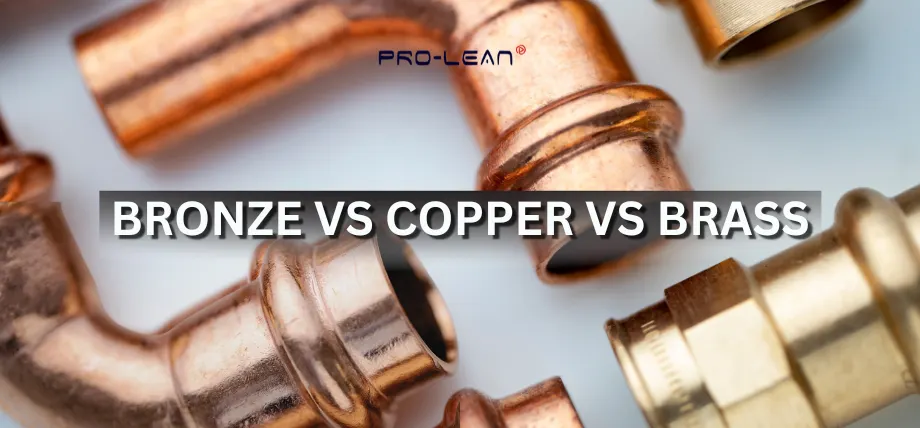
Bronze, copper and brass fittings
Introduction
Brass and bronze have influenced human history and are essential in manufacturing processes and parts. These materials are confusing because they are copper-based alloys and look alike, but have different attributes.
This makes them useful for specific jobs. Engineers, designers, and producers must understand the differences between brass, bronze, and copper. To pick the right metal for their project
This article compares bronze, brass, and copper. It talks about compositions, properties, applications, and key industry aspects so you can make an informed decision.
Overview of Bronze, Brass, and Copper
Copper is a naturally occurring, pure metal known for its excellent electrical and thermal conductivity.
Brass is an alloy primarily composed of copper and zinc, valued for its malleability and aesthetic appeal. Bronze, another copper alloy, consists of copper and tin, often with additional elements, and is prized for its strength and corrosion resistance.
Each metal’s unique characteristics make it indispensable across electronics, construction, and art industries.
Importance of Understanding Metal Differences
Copper occurs naturally and has a high electrical and thermal conductivity. Brass consists mainly of copper, along with zinc. It holds significant value due to its malleability and appearance.
Bronze is another copper-based metal alloying tin, sometimes with other elements. Bronze is widely regarded for its corrosion and damage resistance.
Every metal possesses different attributes, making them highly versatile. Because of that, each has a place in sectors like electronics, construction, and art.
Overview of Copper
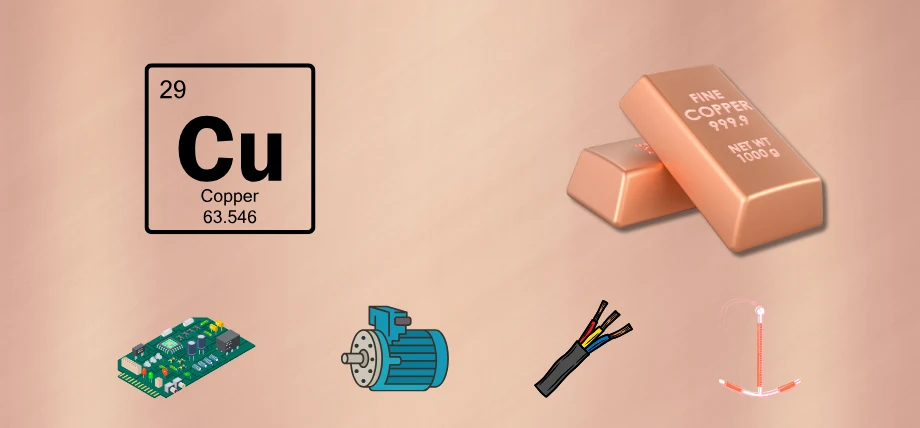
Copper ingot and its uses
Definition and Basic Properties of Copper
Copper is a metallic element on the periodic table (Cu) with a reddish-brown colour. Copper has excellent electrical conductivity and has traits like malleability, ductility (easily shaped), and does not corrode quickly. These properties make it suitable and ideal for creating precise parts in various applications through laser cutting copper.
Because copper has antimicrobial properties, it is helpful in applications such as water purification and plumbing systems.
Highly pure copper, such as oxygen-free or electrolytic grades, is used in applications requiring excellent electrical conductivity, such as high-end wiring and electronic components.
Historical Significance of Copper

Copper artifact
People have been using copper for millennia, and evidence shows its use dating back 8000 BCE. It stood among the early metals worked by humans. Additionally, it shows the shift from the Stone Age toward the Copper Age.
Copper can be made into various things, such as tools, weapons, and ornaments. It set the base for early metallurgy, eventually developing metal alloys such as bronze and brass.
Copper Today
Copper remains a fundamental component of modern tools and components due to its superior electrical conductivity. It makes wires, circuit boards, and electrical creation setups.
Copper is used in piping systems, roofs, and energy setups, like solar power collectors, because of its durability, long life, and reusability.
Copper is combined with other metals to make alloys with specific features tending to various needs. This process is known as alloying; brass and bronze are copper-based alloys.
Try Prolean Now!
Overview of Brass
Brass objects
Definition and Composition of Brass
Brass contains copper and zinc. Copper is the primary metal, making up 55-95 % of the compound. The amount of zinc affects brass’s characteristics. Higher zinc amounts raise its ability to strengthen and harden, and reduce formability or ductility under stress without significantly compromising hardness.
Elements such as lead, aluminium, or manganese can be used to make particular types of brass, like naval brass or free-cutting brass. They are typically produced using melting and casting processes, creating a shiny gold appearance.
Properties of Brass
| Property | Cartridge Brass (C26000) | Naval Brass (C46400) | Free-Cutting Brass (C36000) |
| Density (g/cm³) | 8.53 | 8.41 | 8.50 |
| Tensile Strength (MPa) | 300-600 | 379-607 | 340-470 |
| Hardness (Brinell) | 70-150 | 90-150 | 100-140 |
| Electrical Conductivity (% IACS) | 28 | 26 | 26 |
| Melting Point (°C) | 900-940 | 885-900 | 885-900 |
Source: MatWeb – Copper and Copper Alloys
Brass displays good formability and corrosion resistance. The easy shaping lets shops machine brass for parts with complex geometries, like connectors and flow regulators.
Brass withstands damage from rust, particularly when near unpolluted water, so it lasts a long time in plumbing besides for decoration. Those properties permit brass to be used in various applications and be visually pleasing. For a detailed comparison, see our guide on brass vs copper.
Overview of Bronze
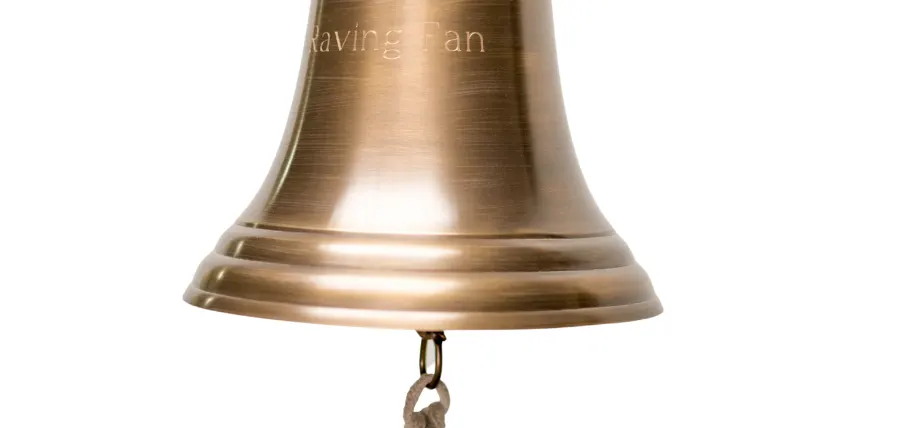
Bronze bell
Definition and Composition of Bronze
Bronze is an alloy with copper and 5-15 % tin as its central part. Other elements like aluminum, phosphorus, or manganese can form different types, such as aluminum bronze or high-leaded tin bronze.
Bronze has gained recognition for its long lifespan, ability to withstand corrosion, and darker, reddish-brown appearance compared to brass. Around 3500 BCE, during the Bronze Age, it was widely used for making tools and weapons.
Properties of Bronze
| Property | Phosphor Bronze (C51000) | Aluminum Bronze (C95400) | High-Leaded Tin Bronze (C93200) |
| Density (g/cm³) | 8.86 | 7.6 – 7.8 g | 8.93 |
| Tensile Strength (MPa) | 325-690 | 515-690 | 240-310 |
| Hardness (Brinell) | 80-200 | 140-170 | 65-90 |
| Electrical Conductivity (% IACS) | 15 | 13 | 12 |
| Melting Point (°C) | 950-1050 | 1025-1040 | 850-975 |
Source: MatWeb – Copper and Copper Alloys
Bronze has good strength and resists breakdown from chemical reactions. Because it has high tensile strength, it works well in machines with heavy loads, such as bearings and boat parts enabling precise fabrication and CNC machining of bronze.
Bronze does not readily corrode in saltwater. Aluminum bronze alloys perform exceptionally well in this area. These qualities help bronze work well in industrial and marine settings.
Metal Alloys: Copper, Brass, and Bronze
Copper Alloy: Composition and Characteristics
A copper alloy results from mixing copper with different substances to change its traits. Two typical copper alloys are brass and bronze.
Other examples of copper alloys include Tellurium copper and nickel silver. Copper alloys display better chemical damage resistance, greater shape ability, and greater solidity than unmixed copper, making them suitable for various applications.
Brass Alloys: Types and Variations
Brass alloys vary based on zinc content and additives. Common types include:
- Cartridge Brass (C26000): 70% copper and 30% zinc, used for ammunition casings.
- Naval Brass (C46400): Includes tin for enhanced corrosion resistance, ideal for marine hardware.
- Free-Cutting Brass (C36000): Contains lead for superior machinability, used in fittings.
- Brass Alloy 330: Low-lead, suitable for cold-working in piping.
- Yellow Brass: High zinc content for a bright, gold-like appearance.
- Architectural Brass (C38500): Used in construction for structural integrity.
These alloys of brass cater to diverse needs, from decorative to industrial.
Bronze Alloy: Composition and Variants
Bronze alloys are tailored for specific applications. Standard bronze alloys include:
- Phosphor Bronze (C51000): Contains phosphorus for hardness and low friction, used in springs.
- Aluminum Bronze (C95400): High strength and corrosion resistance, ideal for marine fittings.
- High-Leaded Tin Bronze (C93200): Used for bushings and non-pressure components.
- Tin Bronze: Traditional bronze with 3-14% tin, used for wear-resistant parts.
Bronze’s versatility stems from its ability to incorporate elements like aluminum or phosphorus, enhancing its durability.
Metal Alloy Production Processes
The production of Brass bronze begins with copper ore excavation, followed by refinement for pure copper. Elements such as zinc and tin are added to make an alloy.
Brass production involves combining melted copper and zinc. For bronze, copper is mixed with tin; sometimes, more elements are added to enhance specific properties. Shaping comes via casting, forging, or extrusion that forms sheets, rods, or components from the alloys.
Recycling is common. About 90 % of brass alloys get reused. Their non-ferromagnetic property makes them easier to separate and facilitates this process.
Try Prolean Now!
Comparative Analysis of Properties
Properties of Copper
Copper has good electrical and heat transfer properties. These characteristics make it a standard comparison for other metals, rated at 100 % IACS.
The metal’s pliability allows for simple forming, and its ability to withstand deterioration makes it appropriate for water pipes and building covers.
Grades of Copper
- Oxygen-Free Copper: (C10100): High-purity copper for electronics.
- Electrolytic Copper: Used in wiring and circuit boards.
- Tellurium Copper (C14500): Enhanced machinability for precision components.
Copper’s conductivity and formability make it indispensable in electrical applications.
Properties of Brass
Brass has an appearance similar to gold and possesses a density between 8.4 plus 8.7 g/cm³. It resists corrosion, so it is suitable for ornamental and practical uses.
The material is easy to machine, particularly free-cutting brass, allowing easy, detailed production. Its characteristics make it ideal for connectors, taps, and musical instruments.
Properties of Bronze
Bronze possesses greater strength, hardness, and durability relative to brass. Its ability to resist corrosion, especially in saltwater, makes it ideal for work near oceans and factories. Bronze has a higher melting temperature than brass (950-1050°C), which gives it increased toughness.
Differences Between Brass, Bronze, and Copper
Bronze vs Brass
Bronze resists wear more effectively because it has tin, making it ideal for good parts, such as bearings, that experience heavy use or need to endure stress.
Brass bends more easily and is malleable (easy to shape), so it works well in decorations and components made with machines. In severe conditions, bronze can withstand harsh environments and corrosion better; however, brass is often favored for its aesthetic appeal.
Bronze vs Copper
Copper alloys are tougher and more durable than pure copper. While pure Copper alone provides superior electrical flow, alloys such as Bronze are better suited for applications such as boats because they possess greater strength and can handle more stress.
Brass vs Copper
Brass (28 % IACS) does not conduct electricity as well as copper (100 % IACS), but it is tougher and resists corrosion better in particular conditions. Copper’s naturally high conductivity makes it an ideal choice for electrical applications, while brass is favored in manufacturing due to its ease of shaping, which helps production.
Applications Across Industries
Copper Uses
Electrical and electronics systems need copper because of its conductivity. Copper has the highest cost of the three because of its refined state and how much it is in demand.
Besides electrical, copper is used in plumbing for pipe systems and as connectors along the roof due to its corrosion and microbial resistance.
Brass Uses
Brass is used for decoration, hardware, lights, parts manufacturing, and buildings. Its color is similar to gold. Brass is used in clocks and as trim in buildings due to its aesthetic appeal.
Brass is used to make Trumpets and bells due to its sound traits and how easy it is to work with, making it suitable for musical instruments.
Bronze Uses
In marine and industrial settings, such as factories, bronze, especially aluminum bronze, is used to make propellers, connectors, and pumps due to its resistance to saltwater corrosion.
Statues besides bells are often made of bronze as they are durable, last long, and develop an attractive patina over time.
Fittings and decor often use brass and bronze. Both have excellent corrosion resistance and appearance, making them suitable for locks, hinges, and valves. But bronze performs better when in more challenging conditions.
Copper: Advantages and Disadvantages
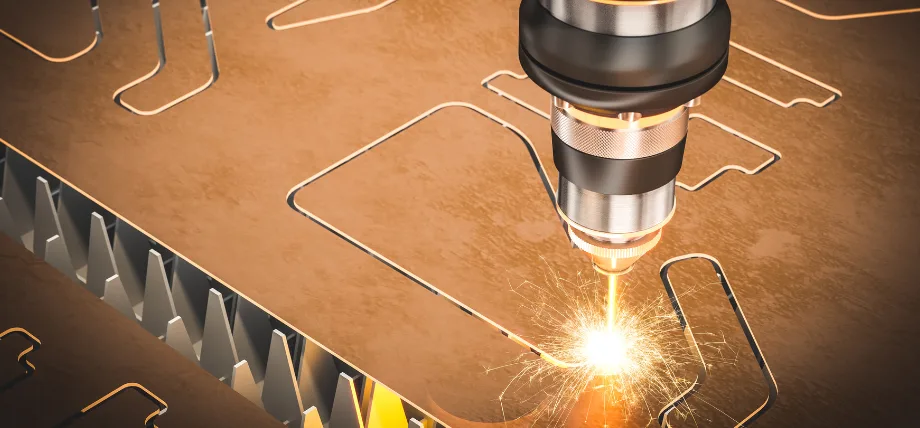
Copper laser cutting
Advantages of Copper
- Copper demonstrates a high electrical conductivity. This characteristic makes it suitable for use in electrical wires and electronics.
- Copper withstands corrosion damage. A layer of oxide builds on the surface and stops corrosion from going deeper. This process extends its life, even in harsh environments.
- Copper conducts heat efficiently, making it ideal for heat exchangers, radiators, and cookware.
- Copper is both ductile(can be drawn into wires) and malleable; it can be flattened into sheets without breaking.
- Copper can undergo recycling repeatedly without any property change. It stays the same through numerous cycles of recycling. This makes copper environmentally friendly.
Disadvantages of Copper
- Copper is soft and does not have a high hardness rating, so it bends, Dents, and scratches easily.
- Copper easily deforms under mechanical stress.
- The cost of copper is higher than that of metals like aluminum or steel, which makes it expensive.
- Over time, copper develops a green copper oxide layer, often called patina. This is undesired in some applications.
- Because of its density, copper weighs a lot. This means it does not work well when weight is a concern.
Brass: Pros and Cons
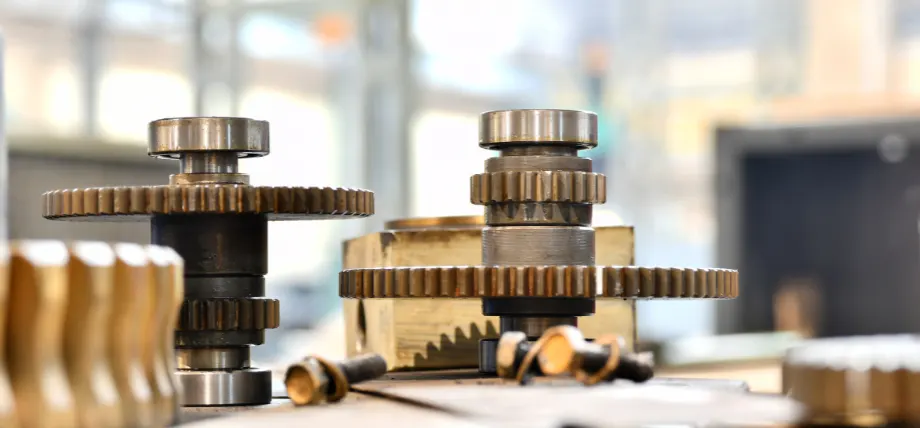
Brass gears
Brass benefits
- It can be shaped easily, making it suitable for detailed designs, musical instruments, and fixtures.
- Good corrosion resistance, especially when exposed to moisture.
- Its bright gold-colored look is valued in decorations.
- Brass is simple to cut, drill, or shape. This lowers production costs and difficulties.
- Low friction makes it suitable for locks, gears, and bearings.
Brass drawbacks
- The capacity to conduct electricity is lower than that of copper. It is not ideal for electrical applications.
- Dezincification is a possibility. Salt or acid can cause zinc loss, weakening the material and making it prone to breaks.
- Some brass contains lead. This is a problem for drinking water systems.
Bronze: Pros and Cons
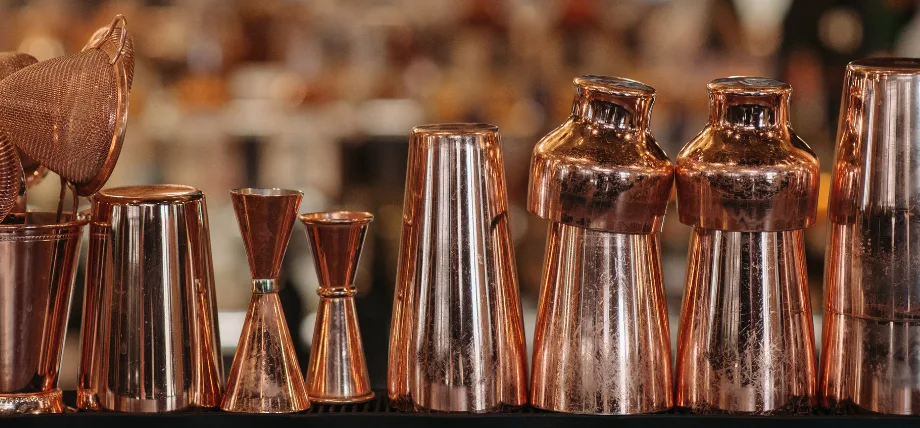
Bronze shakers
Bronze Pros
- Bronze can withstand wear and tear, making it appropriate for machine parts like bushings and bearings.
- It has high corrosion resistance, making it better in marine environments.
- Casting bronze is easy, as it is structurally sound, but it needs to cool down slowly.
- Bronze provides lowered friction when metal slides on metal. This helps with moving parts such as bearings.
- To suit different applications, aluminum, silicon, or phosphorus is added to bronze to tailor its properties.
Bronze drawbacks
- Bronze has a higher melting point than copper., This requires extra energy and special tools to melt as compared to metals such as aluminum or brass.
- Its electrical conductivity is not as good as copper’s. It is not good for uses that demand high electrical flow.
- Some versions of bronze can break easily. This limits use where great pressures occur.
Bronze Needs: Specific Use Cases
Bronze is critical for durable applications, such as marine hardware or heavy-duty bearings, where brass or copper may fail.
Cost and Availability
Market Prices of Copper, Brass, and Bronze
The purest form of copper is expensive because of its demand in electrical and plumbing applications. Copper typically ranges from $4 – $5 per pound ($8 – $11 per kg). Brass is an alloy of copper and zinc and is more affordable, almost half the price of copper at around $8/kg or $4/lbs.
Bronze is a bit more expensive ranging around the same price as copper at about $5 per pound due to the rarity of tin and specialized applications of bronze.
Factors Affecting Metal Costs
In most cases, especially for CNC machining, metal costs are affected by supply chain issues, demand and production factors. Since copper and other metals come from mines, any mining disruptions can lead to an increase in prices.
Brass and bronze are alloys of copper, so their prices are linked ot the demand and supply of refined copper in the market. Another issue in metal prices is tariffs and taxes, especially for alloys that can add expenses.
Some environmental acts can also add to costs to promote the recyclability of metals. However, pure materials still remain expensive.
Application Requirements
Another aspect of pricing is form and application. Copper tubings and copper wires cost differently for the same weight. The application of metal requires different forms and shapes of the alloys, which can increase or decrease costs.
Brass is ideal for plumbing and fittings, making brass stocks and workpieces in standard cylindrical or rectangular shapes. Plumbing alloys of brass (C3600) are more common and slightly cheaper than C48500 which is a high leaded naval brass used in propellers.
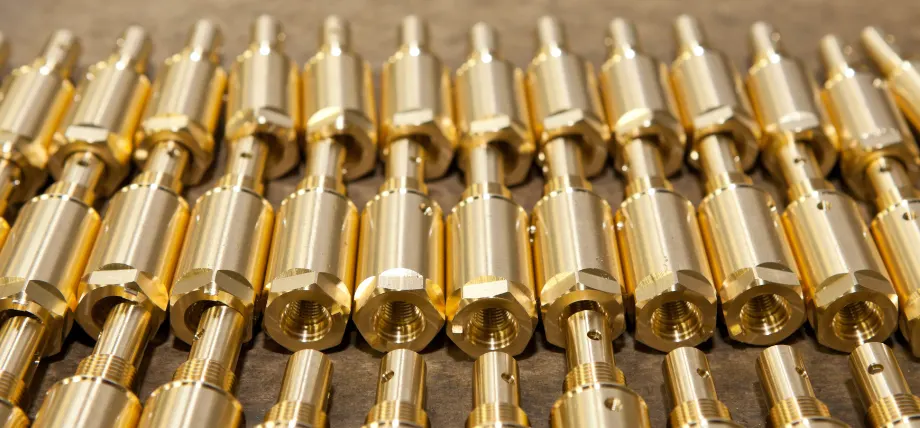
Brass parts
Aesthetic and Functional Preferences
Aesthetic and functional uses dictate material choice. Copper’s brown tones and reddish hue is ideal for exposed pipes and artistic installations, but over time, it can tarnish. Brass has a golden hue and is preferred for decorative hardware, musical instruments and plumbing fixtures, offering workability and aesthetic trims.
Bronze’s natural patina is preferred for statues and architectural elements, enhancing durability in corrosive environments.
Material Machining at Prolean-Tech
Prolean-tech offers custom CNC machining services for brass, copper, and bronze. Prolean-Tech hosts metal alloys suitable for various industries, from marine to aerospace and decorative items.
Learn more about materials through our guides and request a free quote today!
Conclusion
The choice of bronze vs copper vs brass depends on the specific application of your part. Copper parts are primarily used for their electrical conductivity, it’s relatively soft compared to brass and bronze, which nullifies its use in structures.
Brass has zinc alloyed with copper, which increases strength, durability, corrosion resistance and gives it a brighter finish useful in decorative applications. Bronze, an alloy of copper and tin, is primarily used for its excellent corrosion resistance and high strength, suitable for applications like bearings and bushings.
In terms of price, copper has more consistent prices because brass and bronze prices depend on the specific grade and alloy. In the end, the evaluation for the right choice between bronze, copper and brass depends on their longevity, durability and in some cases, visual appeal.

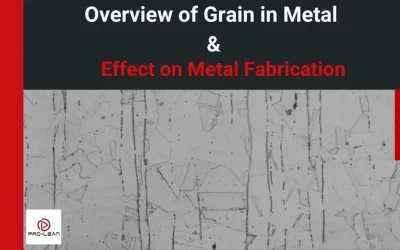
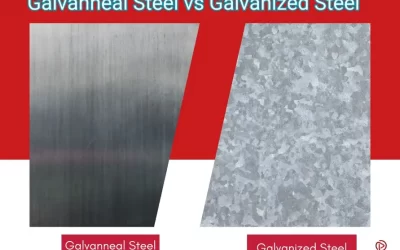
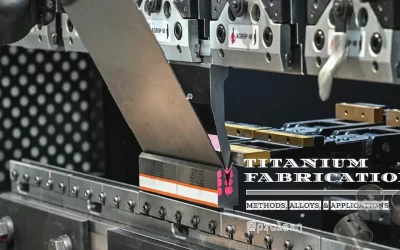
0 Comments